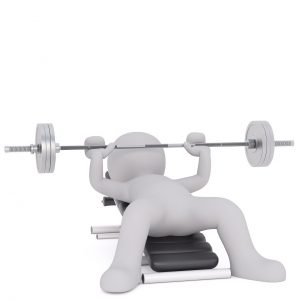Section 5: What about high impact exercise? Copy
The Potential of HIGH IMPACT Programs
The mechanostat theory (Frost et al., 1987) dictates that bone adaptation is a response system likened to a thermostat in which a set point, or minimum effective strain (MES), is determined by internal & external factors and therefore respond to loads above or below these MES points with either bone formation or resorption. Simply put, load the bone above its natural MES, and it will adapt the bone to support the new demand; conversely, unloading the bone (below its MES) and the BMD will decline to meet its new metabolic environment.
Animal studies have provided information regarding mechanical loading for optimal bone formation: Expand- Strain from loading must be of high magnitude.
- A high rate of strain provides a greater osteogenic stimulus than same peak strain achieved gradually.
- Bone adaptation is driven by unusual strain distributions and may stimulate an osteogenic response at a lower MES
- Cycles of loading are unimportant beyond a certain threshold (Kato et al., 2006; Moseley et al., 1998; Rubin et al., 1985
- RCTs investigating brief, high-impact exercise in premenopausal women have shown significant improvements of hip and/or spine BMD (Bassey et al., 1994; Bassey et al., 1998; Kato et al., 2006; Vainionpaa et al., 2005; Winters-Stone et al., 2006)
- similar programs applied to postmenopausal women do not show any significant trends to improving BMD (Bassey et al., 1998)


Bottom Line
Theoretically, brief, unique, high impact exercise should induce bone formation. Research supporting this theory exists in premenopausal women, however physiologic factors (ie., hormonal, co-morbidities, aging) may prevent similar adaptions in older adults, and other factors (pain, restrictions with co-morbidities, fear, etc.) may prevent the safe or successful implementation of high impact programs in older adults.
LIFTMOR trial, Watson et al. (2018)
- Supervised group exercise, high intensity resistance training (deadlift, overhead press, back squat) at 80-85% 1RM (5 sets of 5 reps) + impact loading (jumping chin ups with drop landing)
- 8 months, 2x/week, 30 minutes
- 101 (52 control, 49 exercise) healthy older adults with osteoporosis and no underlying musculoskeletal or cardiovascular comorbidities (excluded people with a recent fracture)
- 1 participant reported low back strain, but did not withdraw from the study
- Found improved lumbar spine and femoral neck BMD compared to control group, and improved lower extremity and back extensor strength, TUG, five time sit to stand, and functional reach test
- BUT did not measure vertebral fractures post and excluded people with a recent fracture – silent could have occurred throughout program
Play the below audio to hear our trainer speak about the LIFTMOR trial.
ReferencesBassey, E. J., & Ramsdale, S. J. (1994). Increase in femoral bone density in young women following high-impact exercise. Osteoporos Int, 4(2), 72-75.
Bassey, E. J., Rothwell, M. C., Littlewood, J. J., & Pye, D. W. (1998). Pre- and postmenopausal women have different bone mineral density responses to the same high-impact exercise. J Bone Miner Res, 13(12), 1805-1813.
Frost, H. M. (1987). The mechanostat: a proposed pathogenic mechanism of osteoporoses and the bone mass effects of mechanical and nonmechanical agents. Bone Miner, 2(2), 73-85.
Kato, T., Terashima, T., Yamashita, T., Hatanaka, Y., Honda, A., Umemura, Y. (2006). Effect of low- repetition jump training on bone mineral density in young women. J Appl Physiol, 100: 839-843.
Mosely, J.R., Lanyon, L.E. (1998) Strain rate as a controlling influence on adaptive modeling in response to dynamic loading of the ulna in growing male rats. Bone, 23: 313-318.
Rubin, C. T., & Lanyon, L. E. (1985). Regulation of bone mass by mechanical strain magnitude. Calcif Tissue Int, 37(4), 411-417.
Vainionpaa, A., Korpelainen, R., Leppaluoto, J., & Jamsa, T. (2005). Effects of high-impact exercise on bone mineral density: a randomized controlled trial in premenopausal women. Osteoporos Int, 16(2), 191-197.
Watson SL, Weeks BK, Weis LJ, Harding AT, Horan SA, Beck BR. High-Intensity Resistance and Impact Training Improves Bone Mineral Density and Physical Function in Postmenopausal Women With Osteopenia and Osteoporosis: The LIFTMOR Randomized Controlled Trial. J Bone Miner Res. 2018; 33(2):211-220. doi:10.1002/jbmr.3284
Winters-Stone, K. M., & Snow, C. M. (2006). Site-specific response of bone to exercise in premenopausal women. Bone, 39(6), 1203-1209.